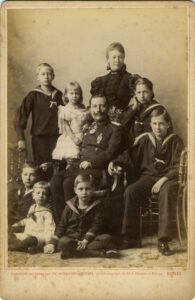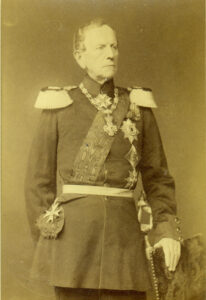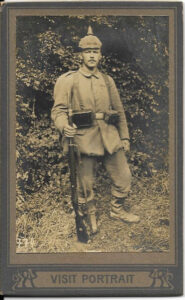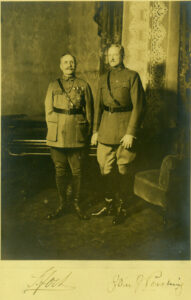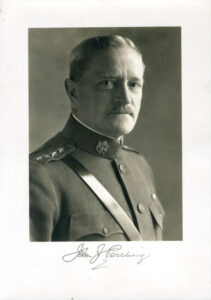Section #11 - Other Military Conflicts
World War I
While some historian regard the 1756-63 Seven Years War between Britain and France as the first truly global conflict, that designation generally rests with the catastrophic struggle from 1914 to 1918. A very superficial recap follows.
World War I – The Great War to end all wars – results from hostilities that carry over from 19th century bloodshed and national losses that easily enflame citizen demands for revenge and conquest. For example, the French never reconcile to the loss of Alsace-Lorraine in the Franco-Prussian War.
To boost each nation’s capacity to survive any future blows, intricate defense alliances are negotiated, the most crucial being the:
- The Triple Alliance uniting Germany, Austria-Hungary and Italy, which originates in 1882 after the Franco-Prussian conflict and that endures until its expiration in 1915; and
- The Triple Entente which follows the Franco-Russian pact of 1894 and the 1904 Entente Cordiale agreement between London and Paris.
Lurking behind these accords is also the fact that three of the monarchs involved are relatives: King George V and Kaiser Wilhelm II are grandsons of Queen Victoria and Tsar Nicholas II is married to her granddaughter, Alexandra. Along with these ties come certain signs of jealousy and competitiveness that plays into the outbreak of the war. One example being Wilhelm’s determination to build a “High Sea’s Fleet” of Dreadnought battleships to offset the dominance of Britain’s “Grand Fleet.”
But the war itself is sparked on June 28, 1914 in the Bosnian town of Serajevo when Archduke Francis Ferdinand, heir apparent to the crown of Austria-Hungary, is assassinated by a Serbian member of the Black Hand. What follows from this act are a series of humiliating ultimatums directed at Serbia, which finally looks to its ally, Russian Tsar Nicholas I, to intervene on its behalf with Germany to temper Austria-Hungary. But messages between Cousins “Nicky and Willy” only add to the tension and increase expectations for a coming war.
Both sides have elaborate plans in place for the outbreak and both believe that the first to mobilize their troops in line with railroad timetables will have a distinct advantage. This pressure leads Germany to declare war on Russia, France and Belgium on August 3; Britain declares against Germany on August 4; Austria-Hungary against Russia on August 6; Britain and France announce vs. Austria-Hungary on August 14; and soforth. The world is officially at war.
The militaristic Germans strike first according to their “Schlieffen Plan,” violating Belgium territory and swooping west along the Channel to hopefully encircle the French Army around Paris. But uncertainties cause them to veer south early, leading to exposure of their right flank along the River Marne, where General Gallieni and Joseph Joffre, overall commander of French forces until 1916, hand them a decisive defeat by September 4, 1914.
Once the “Miracle on the Marne” halts the Germans, they focus on consolidating their early territorial advances by “racing north to the Channel,” securing one Belgium town after another, and digging elaborate trenches to ward off retaliations by France.
This “trench warfare” strategy marks the rest of World War I. Two sides, dug in, hurling enormous artillery shells at each other, interrupted by occasion attempts at offensive maneuvers across “no man’s land” typically stopped by the killing power of machine guns.
This tragic slugfest lasts for four years with the “flower of the next generation” ending up dead or wounded on the battlefields. Estimates peg the total casualties, military and civilian, at some 20 million. Financial costs are pegged at over $200 Billion, with cities leveled to the ground along with the infrastructure needed to maintain a civil society.
Four theaters of war define the combat: the Western, Eastern, Italian and Balkan “Fronts.”
The Eastern theater finds the Germans, led by Generals Paul Hindenberg and Eric Ludendorf, crushing the Russian army at Tanneberg on August 30, after which Russian General Samsamov commits suicide. From then on, Germany will continue to try to take Russia out of the war so they can concentrate in the west.
In the West, two crucial battles occur in 1916. The first involves a 9 month-long siege by the Germans beginning in February along the Meuse River at Verdun, a French salient near Alsace-Lorraine. Verdun becomes a matter of honor for France and its chief defender, Field Marshal Philippe Petain, assures the public “they shall not pass.” The Germans recognize the French commitment and step up their attacks, in part to remove the enemy from linking up with Britain to the west. In the first phase, the Germans, under Falkenhayn, capture the theoretically impregnable Fort Douamont northeast of the city. After that repeated German attacks are repulsed. The futile assaults continue until December 1916 when a counter-offensive by Petain and General Robert Nivelle re-captures Douamont. Falkenhayn is sacked on August 29 and Hindenberg, Ludendorff and Crown Prince Wilhelm to end the campaign. By that time, the butcher’s bill for the 302 days at Verdun is beyond belief, with France losing nearly 400,000 men and Germany losing 350,000.
On May 31, 1916, the single large-scale encounter between the British and German naval forces takes place at the Battle of Jutland. Until that time the High Seas Fleet has been largely content to shelter in its Heligoland base. This changes when Rear Admiral Reinhard Scheer becomes head of the German forces in January 1916. When Scheer ventures out into the North Sea with his 21 ships in May, the British, under Sir John Jellicoe and his second, David Beatty, steam east from Scapa Flow with a fleet of 37 to meet him in the open. The two meet off the northwest coast of Denmark at Jutland where a confused and ultimately indecisive battle results in Britain’s loss of fourteen vessels against German’s loss of eleven. In the end both commanders decide to break off and protect their assets for another day rather than risk them all at once. After Jutland, the Germans turn to submarines to try to control the seas.
The second great land slaughter of 1916 occurs 185 miles to the west along the River Somme. The original intent here is to launch a combined British-French assault, but Britain has to go it alone with France occupied at Verdun. Thus the British Expeditionary force under Sir Douglas Haig and General Henry Rawlinson advances on July 1, 1914, along a 15 mile arc north of the River Somme. It is preceded by a 1.5 million shell barrage of the German trenches and the explosion of some 19 mines secretly dug under the enemy positions. Before “going over the top,” the British troops are told that their foes are already dead, and several units are seen playfully kicking soccer balls ahead of them as they advance. But twelve hours later, over 57,000 have been killed or wounded in the single greatest defeat in British history. Once again the pattern of a strong defense defeating a risky offense plays out.
The course of the war changes in 1917, with the most profound strategic aspect being the entrance of America into the cauldron. This begins with on January 31 with Germany’s announces of unrestricted submarine warfare which causes U.S. President Woodrow Wilson – elected in 1914 to keep America out of the war – to suspend diplomatic relations with Berlin. Matters then worsen when Britain intercepts and publishes a telegram from Foreign Minister Arthur Zimmerman fatuously proposing an alliance between Germany and Mexico. Hearing of this, Wilson declares that “the world must be made safe for democracy” and Congress declares war on Germany on April 6, 1917. The Americans are ill-prepared for battle and in need of building an expeditionary army which doesn’t reach Europe until June 1917. And at that point its overall commander, John “Black Jack” Pershing maintains its independence from French control and waits until May 1918 to unleash it in combat at Cantigny.
The Spring of 1917 also witnesses the collapse of Nicholas II’s reign in Russia. The Tsar loses touch with his devoted serfs amidst concerns for his hemophiliac heir Alexi, intrigues surrounding the interloper Rasputin and the incompetence of his generals and close advisors. As living conditions deteriorate, protests break out in St. Petersburg and Nicholas is forced to resign on March 15. With Germany’s help, Vladimir Lenin arrives in the capital, installs his communist regime, and begins a year-long struggle with the White (pro Crown) Russians to control the empire. He succeeds, and on March 3, 1918 Russia exits the war. To prevent any return to the monarchy, Nicholas, Alexandra and his five children are murdered on July 17 at the Ipatiev “house of special purpose” in Ekaterinburg.
In April 1917 the leading French proponent of “elan,” General Robert Georges Neville launches what he assures Joffre will be the answer to the stalemate of trench warfare. His not altogether new idea lies in finding weak points in the German lines, pouring overwhelming artillery and troops at them to cause sustainable breakthroughs. He chooses the ridge along the Chemin des Dames in the northern Artois region of France and hurls his army toward the town of Arras. On April 9 Neville’s Canadian troops capture Vimy Ridge, but then the Germans concentrate their forces and the effort stalls. The fiasco costs the Allies about 120,000 casualties against the German losses of only 20,000. It also produces a mutiny in the French army where the soldiers stay in their trenches but refuse to attack. (Some 28 men are subsequently executed.) In May, Neville is sacked and replaced by the Lion of Verdun, Petain.
The three battles for the Belgium town of Ypres mark the last great offensive of 1917. They begin in July 1917 and take place around the British salient in Flanders, some 60 miles inland from the Channel port of Calais. The final thrust known as the Battle of Passchendaele begins on September 20, with the British commanded by Sir Hubert Gough, one of Haig’s favorite generals. Heavy rains literally bury the troops in mud, and Lloyd George tries repeatedly to have Haig end the fiasco. It finally ends on November 10, 1917 when Gough marches into a totally flattened and abandoned town. Year later, Prime Minister George calls Ypres: “one of the greatest disasters of the war … No soldier of any intelligence now defends this senseless campaign.” Ypres is also recalled for the German’s resort to chemical warfare in the form of lethal chlorine gas in 1915.
The final year of 1918 finds the U.S. in the war, Russia out, and the populations of all the countries involved struggling to survive the ordeal and soon to be faced with an outbreak of the deadly “Spanish flu” virus.
On March 21 Ludendorff unleashes the final German offensive beginning on the Somme and dropping south to the Artois. Early advances are halted after the allies agree on April 14 to put General Ferdinand Foch in command over all Allied Troops. His promise: “I would fight in front of Amiens…I would fight all the time.” The Germans re-group and start up again, moving an amazing 10 miles on a single day (May 27) and reaching the Marne on June 3, only 56 miles from Paris. Panic marks the city until Foch sends in reinforcements to again frustrate the advance. Then a last gasp effort on July 15 is stopped as the French going on an offense of their own. Ludendorff will call August 8 “the black day of the German army,” the moment when the chance for victory comes to an end.
The American army, now a half-million men strong, makes its present felt. Back in May their first engagement has been a victory at Cantigny and by September Pershing has agreed to follow Foch’s lead. On September 12 they play a major role at the battle of St. Mihiel and then go on to clear the Argonne Forest as part of Foch’s Meuse-Argonne offensive.
Fearing further set-backs, Ludendorff insists on peace discussions in late September. His hope, however, is simply that Germany will retreat to its original borders without any further retribution by the allies. But Foch and Prime Minister Clemenceau join Pershing in demanding unconditional surrender, and so the fighting continues until a final cease fire goes into effect at 11:00am on November 11, 1918 – with another 2700 soldiers killed on the last day.
Ludendorff is unceremoniously sacked on October 26, with the Kaiser turning to Hindenburg to save the army and the nation. On November 9, 1918 Wilhelm II resigns and moves to the Netherlands where he lives in comfort until 1941, hoping at the end that Adolph Hitler might restore his monarchy.
The American’s final impact on the Great War rests with President Woodrow Wilson who meets with the new German Chancellor, Max von Baden, to find peace terms that Germany will find acceptable. In this, and in his attempt to create the League of Nations, Wilson fails. The result being the severe punishment of the Treaty of Versailles which destabilizes Germany and leads on to Hitler and the Nazis.
In Flanders fields the poppies blow
Between the crosses, row on row,
That mark our place; and in the sky
The larks, still bravely singing, fly
Scarce heard amid the guns below.
